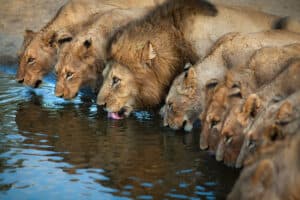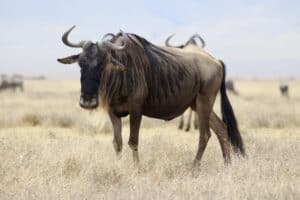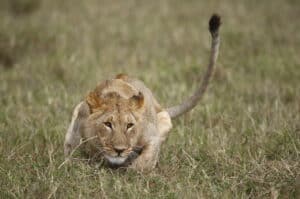Lions are the most social of all big cats. They live in groups called prides, which can consist of three to 30 lions, depending on the region and availability of food. To maintain social cohesion and avoid confrontation with other prides, lions use a range of vocalizations, body language, scent marking, and tactile communication.
Read on to learn more about how lions communicate with each other.
How Do Lions Communicate: Vocalizations
African and Asian lions (Panthera leo) use various vocalizations to facilitate interspecific communication. These calls can communicate intentions, emotions, desires, navigational instructions, and warnings between pride members and different prides. These vocalizations include grunts, roars, meows (when young), growls, snarls, moans, huffs, hums, and hisses.
Roars
Roars are perhaps the most famous of the lion calls. All lions can roar. This call typically presents with territorial behavior. Males and females of a pride will often roar in unison when a nearby pride is detected to announce their formidable presence. Interestingly, the other pride of lions can detect if the roaring pride is bigger than theirs by listening to the chorus of roars. If they determine the roaring pride is more significant, the listening pride will typically remain silent and possibly leave the area. If, however, the listening pride determines that the roaring pride is of equal or smaller size, they will roar back in an assertion of their collective power. Male lions of a pride will also roar during patrols of their territory as a means of communicating a warning to other males within or near their territory. Male lions in bachelor coalitions do not tend to roar until they become resident members of their own prides. The mighty roar of a male lion can be heard by other lions up to 5 miles away!
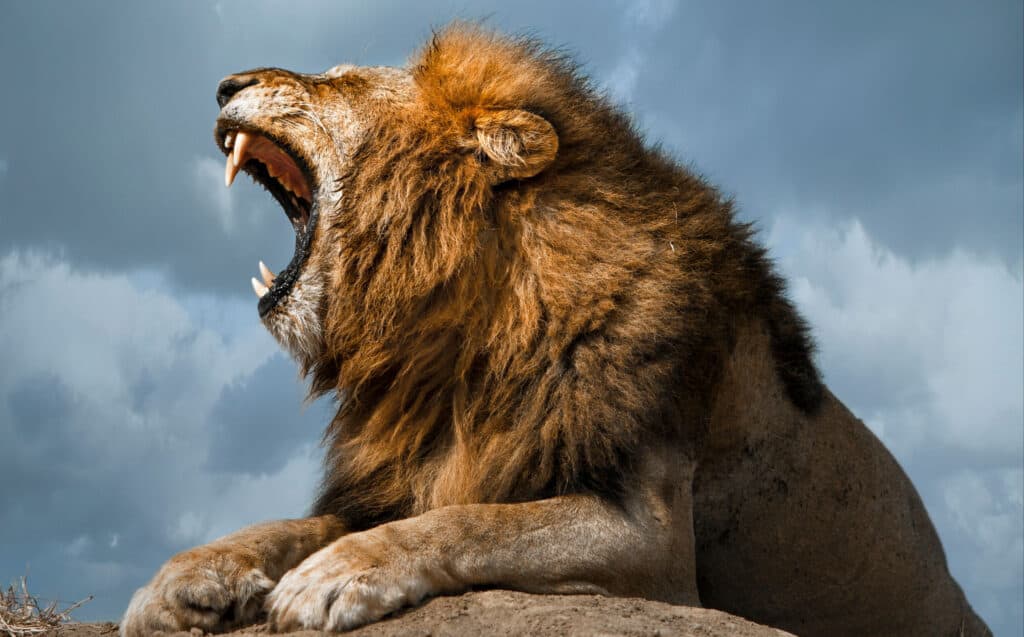
Lions typically roar to announce themselves and defend their territories.
©Henrico Muller/Shutterstock.com
Friendly Vocalizations
Lions use friendly vocalizations to express affection and maintain social bonds between members of their pride. Grunts, purr-like growls, sneeze-like puffs, and meows are used during warm greetings and interactions. Only lion cubs can meow, and they typically do so to locate each other and to request affection or food.
Aggressive or Defensive Vocalizations
Lions can express aggressive intent or defensiveness through several vocalizations. This includes roars, snarls, hisses, fierce growls, and angry huffs. Lions may use these vocalizations to express irritation with another pride member or during ritualized aggression to avoid a physical conflict.
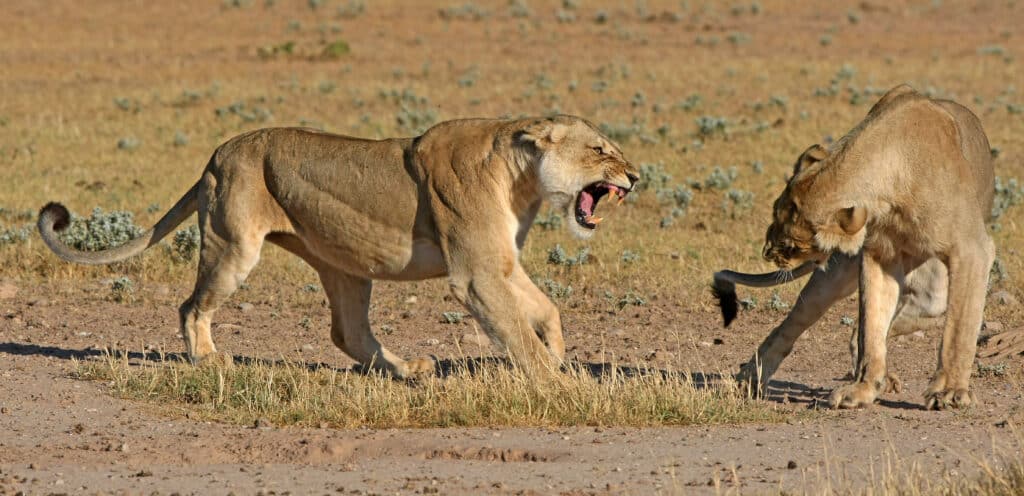
Lions can express defensiveness or aggression through vocalizations such as short roars, snarling, and fierce growls.
©Seyms Brugger/Shutterstock.com
How Do Lions Communicate With Each Other: Body Language
Lions also use a range of body language signals to communicate emotions and behavioral intent with members of their species. They primarily use their ears, tails, facial expressions, and body posture.
Aggressive and Irritated Body Language
Lions can express threatening intentions and irritation through various postures and facial expressions. A lion with offensive or threatening intent may present with a lowered head, heightened shoulders, wide-stanced forelegs, wide-eyed staring, and a vertically whipping tail. Their mouth may be slightly open, with their lips pulled straight back and ears twisted to reveal their noticeable black markings. The overall posture is stiff. These signals may appear before a lion attacks another member of its species or to signal a willingness to fight.
A lion irritated with another pride member may express body language such as a horizontally swishing tail, flattened ears, and paw swatting.
Defensive Body Language
A lion who feels threatened may present with flattened ears, bared teeth, narrowed eyes, and a crouching position. They may also bluff charge. These signals communicate that the lion does not want to fight but will if necessary. If they attempt to appear disarming or non-threatening, they may also lie on their backs in an appeasing gesture.
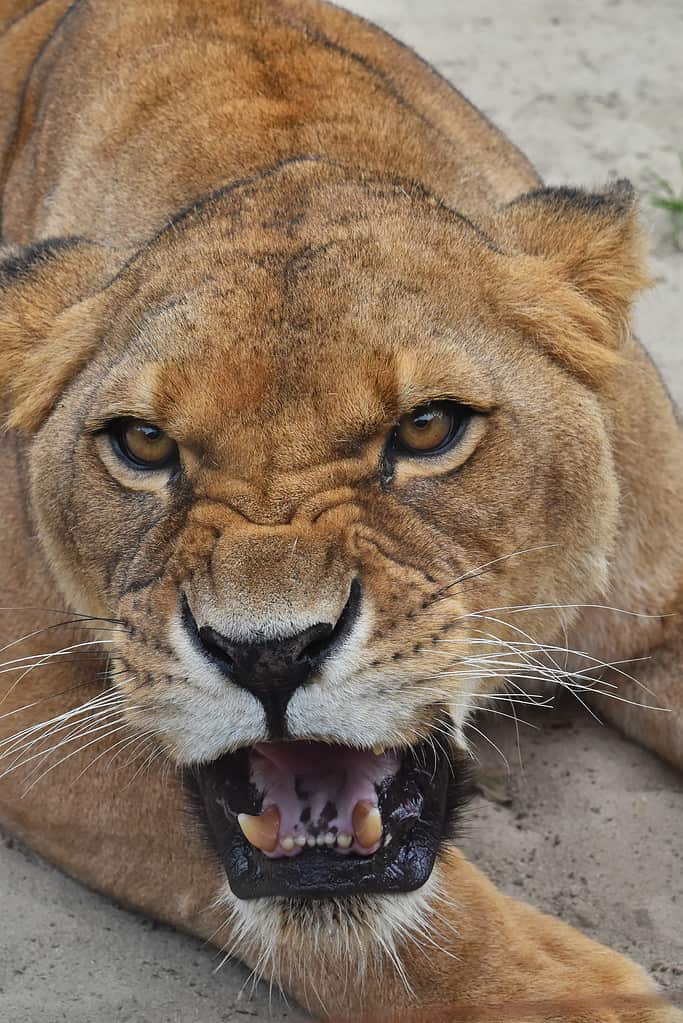
This threatened lioness is snarling and low to the ground with narrowed eyes and flattened ears.
©BreakingTheWalls/iStock via Getty Images
How Do Lions Communicate: Chemical Signals
Lions typically use interspecific chemical signaling to indicate healthy reproductive status and as a territorial warning. They spread their scent by rubbing their muzzle on the ground, raking the earth with their hind paws, and urine spraying (only males). Males spray urine during territory patrols to communicate the territorial boundaries to other males. He will also sniff along the route to monitor for scent marking from other males who may be too close or infringing on the pride’s territory.
How Do Lions Communicate: Tactile Communication
Lions are highly tactile communicators. During friendly greetings, they press their heads and sides together, lean against each other, and drape their tails over each other. Head rubbing is significant to maintain and strengthen social bonds between pride members. Mothers will lick their cubs and other females of the pride. Adult females typically lick other adults’ heads, necks, and shoulders as a sign of affection. When irritated, lions slap each other, often on the hindquarters or forehead. This slapping does not usually escalate into serious fights.
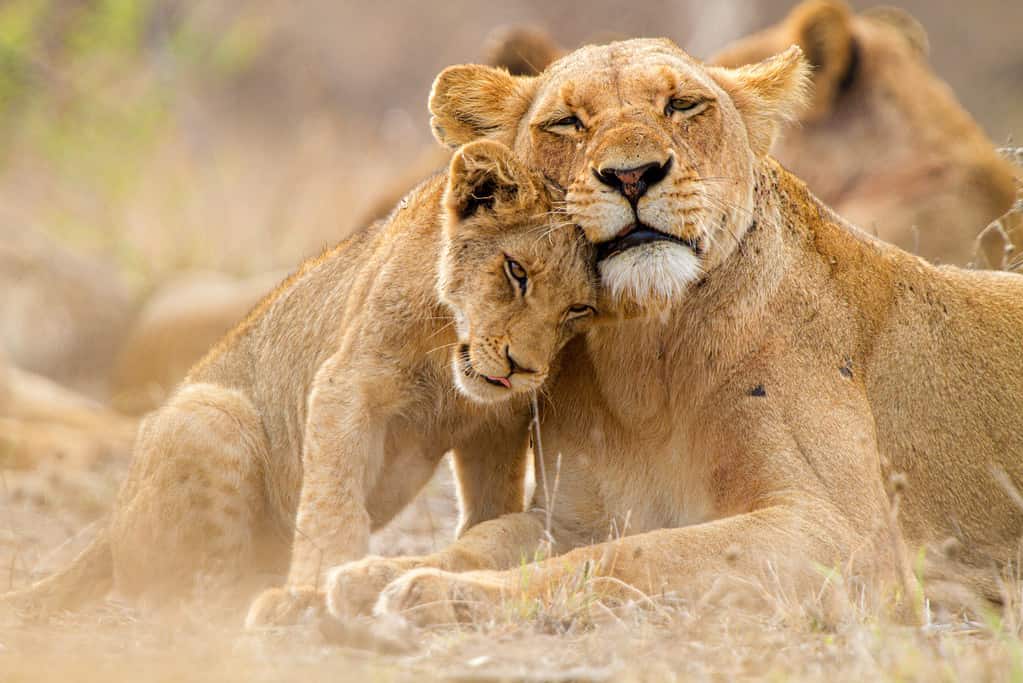
Lions often rub heads together as a form of affection and during greetings.
©Thomas Retterath/iStock via Getty Images
The photo featured at the top of this post is © LuCaAr/iStock via Getty Images
Thank you for reading! Have some feedback for us? Contact the AZ Animals editorial team.




